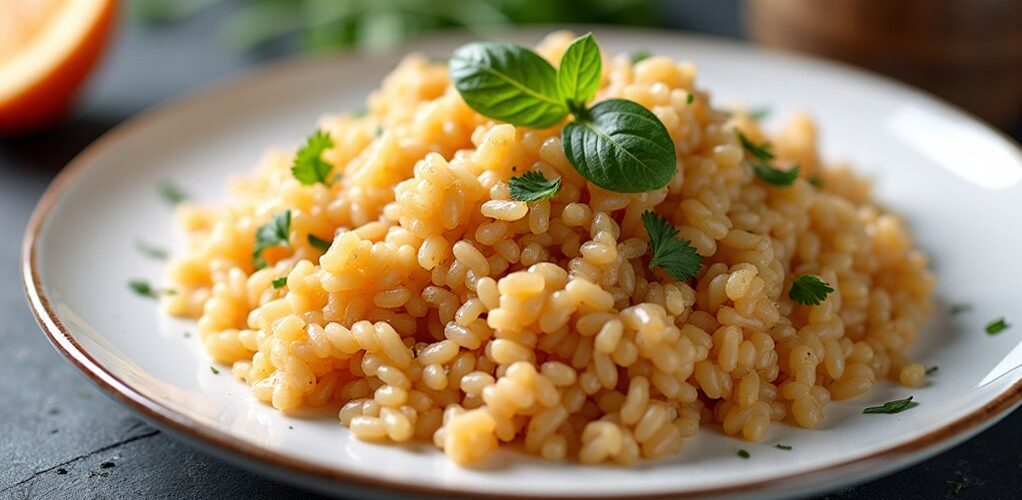
Brown rice is not considered a low-carb food, containing 45 grams of carbohydrates per cooked cup. While it offers nutritional benefits like fiber, minerals, and B vitamins, its carb content exceeds typical low-carb diet limits of 20-50 grams daily. Those following ketogenic or strict low-carb diets should consider alternatives like cauliflower rice, which contains only 2 grams of net carbs per cup. Understanding portion control and suitable substitutions can help integrate brown rice into a balanced meal plan.
Key Takeaways
- Brown rice contains 45 grams of carbohydrates per cooked cup, making it unsuitable for strict low-carb diets targeting 20-50 grams daily.
- Its glycemic index of 65 and fiber content of 3.23 grams make it a better choice than white rice for blood sugar control.
- Consider portion control by limiting to half-cup servings, providing approximately 23 grams of net carbs per serving.
- Alternative low-carb options include cauliflower rice, shirataki rice, and broccoli rice, containing 2-4 grams of net carbs per cup.
- Brown rice can fit moderate-carb diets when paired with proteins and healthy fats, though it's not recommended for ketogenic diets.
Carbohydrate Content in Brown Rice: Breaking Down the Numbers
Understanding the carbohydrate content in brown rice requires a careful examination of its nutritional profile and how it fits into various dietary approaches. A cooked cup of brown rice contains approximately 45 grams of carbohydrates, with 3.23 grams of fiber contributing to its nutritional value.
This fiber content helps differentiate brown rice from refined grains, as it can slow down carbohydrate absorption and assist in blood sugar management.
When broken down into smaller portions, a half-cup serving provides about 23 grams of net carbs, making it a moderate-carbohydrate option. With a glycemic index of 65, brown rice demonstrates a measured impact on blood sugar levels, though it may not align with strict low-carb dietary requirements.
Its higher fiber content, however, makes it a more suitable choice than refined alternatives for those seeking better carbohydrate management.
Understanding Brown Rice's Glycemic Impact
Brown rice demonstrates favorable blood sugar response levels with its glycemic index of 65, offering better glucose management compared to white rice's higher score of 73.
When considering insulin management, brown rice's complex carbohydrates and fiber content work together to prevent rapid spikes in blood sugar, making it a more suitable choice for those monitoring their glucose levels.
While the glycemic index measures how quickly a food raises blood sugar, the glycemic load of brown rice provides a more complete picture by accounting for portion size, helping individuals make informed decisions about their rice consumption within a balanced diet.
Blood Sugar Response Levels
When considering the impact of different rice varieties on blood sugar levels, the glycemic response to brown rice proves significantly different from that of its refined counterpart.
Research demonstrates that brown rice's moderate glycemic index of 65, coupled with its higher fiber content and nutrient density, contributes to a more stable blood sugar response compared to white rice.
- Brown rice's glycemic index (65) is considerably lower than white rice (73)
- Fiber content of 1.6g per 100g helps slow digestion and carbohydrate absorption
- Regular consumption may reduce type 2 diabetes risk
- Nutrient density supports better overall blood sugar management
- Portion sizes remain essential for effective blood sugar control
These characteristics make brown rice a more suitable option for individuals monitoring their blood sugar levels, though mindful portion control remains vital for ideal results.
Managing Insulin With Rice
Maintaining stable insulin levels requires careful consideration of dietary choices, and rice selection plays an essential role in this process. Brown rice, with its glycemic index of 65, offers a more measured impact on blood sugar compared to white rice, making it a strategic choice for insulin management.
The fiber content in this whole grain variety contributes greatly to its metabolic benefits, helping to moderate digestion and stabilize insulin levels throughout the day.
Research demonstrates that regular consumption of brown rice correlates with improved glycemic control and a decreased risk of type 2 diabetes. This advantage stems from both its fiber content and the presence of beneficial nutrients like magnesium, which supports insulin sensitivity.
When incorporated into meals, brown rice typically results in lower post-meal blood sugar spikes than its refined counterpart.
Glycemic Load vs. Index
Understanding the distinction between glycemic index and glycemic load provides essential context for evaluating brown rice's impact on blood sugar levels. While brown rice's glycemic index of 65 indicates its general effect on blood sugar, glycemic load offers a more precise measure by accounting for portion size and preparation methods.
- Brown rice's lower glycemic index compared to white rice (65 vs. 73) supports better blood sugar control
- Higher fiber content in brown rice slows carbohydrate absorption
- Portion size considerably influences the glycemic load of brown rice
- Brown rice's nutritional profile includes magnesium, supporting glycemic control
- Individual dietary needs should guide portion sizes for ideal blood sugar management
These factors make brown rice a considerable option for those managing type 2 diabetes or seeking balanced blood sugar levels, provided portions are appropriately controlled.
How Brown Rice Affects Ketosis
Despite its reputation as a healthier alternative to white rice, brown rice poses significant challenges for individuals following a ketogenic diet.
With 23 grams of net carbs per half-cup serving, brown rice can quickly consume a substantial portion of the daily carbohydrate intake allowance typical for ketogenic diets, which ranges from 20 to 50 grams.
The high carbohydrate content in brown rice can disrupt ketosis, the metabolic state essential for fat burning on a ketogenic diet. When consumed, these carbs can trigger insulin spikes and shift the body away from using fat as its primary fuel source.
For those committed to maintaining ketosis, low-carb alternatives like cauliflower rice, which contains only 2 grams of net carbs per cup, offer more suitable options for staying within daily carbohydrate limits.
A ketogenic diet can greatly reduce blood glucose levels and support improved insulin sensitivity, making it an effective strategy for managing type 2 diabetes.
Nutritional Benefits Beyond the Carb Count
While brown rice may not align with strict low-carb diet requirements, its nutritional profile extends far beyond its carbohydrate content. The nutritional differences between brown rice and refined grains showcase its superior health benefits.
Brown rice contains an impressive array of essential nutrients that support overall wellness and metabolic function.
- Rich in dietary fiber, promoting digestive health and blood sugar control
- Contains crucial minerals like magnesium and phosphorus
- Provides B vitamins essential for energy metabolism
- Features a moderate glycemic index of 65
- Higher protein content than white rice, supporting satiety
These nutritional attributes make brown rice a valuable food choice for those focusing on overall health rather than solely carbohydrate reduction.
Its fiber content and nutrient density contribute to sustained energy levels and improved digestive function. For individuals managing Type 2 diabetes, incorporating nutrient-dense foods like brown rice can support metabolic health and blood sugar stability.
Portion Control Strategies for Brown Rice
Since brown rice plays a valuable role in a balanced diet, mastering portion control becomes vital for those seeking to manage their carbohydrate intake while still benefiting from its nutritional properties.
Understanding serving size is important, as one cup of cooked brown rice contains approximately 52 grams of carbohydrates. For better dietary balance, individuals can opt for half-cup portions, which provide around 26 grams of carbohydrates.
Using a food scale can guarantee precise measurements, with a standard cup serving weighing about 195 grams. To optimize carbohydrate management, incorporating high-fiber vegetables alongside brown rice helps slow down carbohydrate absorption.
Additionally, integrating smaller amounts of brown rice into mixed dishes like stir-fries or salads offers an effective strategy for portion control while maintaining nutritional benefits.
Alternative Low-Carb Rice Options
For individuals seeking to reduce their carbohydrate intake without sacrificing the comfort of rice-based dishes, several innovative alternatives have emerged in recent years.
While brown rice contains 45 grams of net carbs per cup, these low-carb nutritional options provide similar textures with considerably fewer carbohydrates.
These dietary alternatives have revolutionized how people approach their meals while maintaining nutritional goals.
- Cauliflower rice leads the pack with only 2 grams of net carbs per cup
- Shirataki rice offers the lowest carb content at less than 1 gram per serving
- Broccoli rice provides 4 grams of net carbs with added vitamins and minerals
- Zucchini rice delivers a fresh alternative with 2 grams of net carbs
- Riced cabbage matches cauliflower's 2 grams while adding beneficial fiber
A great keto-friendly pasta alternative is Shirataki noodles, which are low in carbs and calories, making them an ideal choice for those following a low-carb diet.
Balancing Brown Rice in a Low-Carb Meal Plan
Although brown rice presents challenges for those following a low-carb diet, strategic portion control and thoughtful meal planning can make it possible to include this nutritious grain occasionally. To successfully incorporate brown rice while maintaining a low-carb lifestyle, consider limiting portions to half a cup and pairing it with protein-rich foods and non-starchy vegetables for a balanced meal. One effective strategy is to substitute half the brown rice with cauliflower rice, considerably reducing carbohydrate intake while preserving the familiar texture and eating experience. Despite its moderate fiber content of 3.5 grams per cup, brown rice's 45 grams of carbohydrates require careful monitoring to stay within daily carb limits, typically ranging from 20-50 grams on a low-carb diet. It is essential to note that ketosis requires maintaining very low carbohydrate intake, and incorporating brown rice should be done cautiously to avoid disrupting this metabolic state.
Brown Rice vs. Other Whole Grains: Carb Comparison
When evaluating brown rice against other whole grain options, its carbohydrate content proves relatively high at 45 grams per cooked cup, positioning it among the more carb-dense choices.
For those following low-carb diets, understanding how brown rice compares to other nutrient-dense whole grains is essential for making informed dietary decisions.
Here's how brown rice's carbohydrate content compares to other whole grains per cooked cup:
- Brown rice: 45 grams of carbohydrates
- White rice: 45 grams of carbohydrates
- Barley: 44 grams of carbohydrates
- Quinoa: 39 grams of carbohydrates
- Bulgur: 33 grams of carbohydrates
While brown rice offers valuable nutrients, alternatives like quinoa and bulgur provide lower-carb options while maintaining the benefits of whole grains.
Managing Blood Sugar With Brown Rice Consumption
Brown rice emerges as a superior choice for blood sugar management due to its lower glycemic index and higher fiber content compared to refined grains.
With a glycemic index of 65, brown rice helps prevent rapid blood sugar spikes that are commonly associated with white rice consumption.
The grain's fiber content of 1.6 grams per 100 grams plays an essential role in slowing glucose absorption, while its magnesium content supports insulin sensitivity and metabolic health.
Current dietary guidelines recognize brown rice's potential in reducing type 2 diabetes risk, making it a valuable addition to balanced meals.
When combined with protein and healthy fats, brown rice consumption can contribute to stable blood sugar levels throughout the day, offering a practical approach for those monitoring their glucose response.
Preparing Brown Rice to Reduce Carb Impact
Preparing brown rice strategically can greatly reduce its carbohydrate impact while maintaining its nutritional benefits. Several research-backed methods can effectively lower its glycemic index and optimize carbohydrate absorption. By implementing specific preparation techniques, individuals can better incorporate brown rice into their dietary goals.
- Soak brown rice for several hours before cooking to break down starches and enhance digestibility.
- Use a higher water-to-rice ratio when cooking, then drain excess water.
- Add vinegar or lemon juice to the cooking water to reduce glycemic response.
- Pair with high-fiber foods like legumes or non-starchy vegetables.
- Allow cooked rice to cool before eating to increase resistant starch content.
These preparation methods can remarkably impact how the body processes the carbohydrates in brown rice, making it a more suitable option for those monitoring their carb intake.
Best Times to Include Brown Rice in Your Diet
Brown rice serves as an excellent pre-workout energy source, providing complex carbohydrates that fuel sustained physical activity and help maintain steady blood sugar levels.
Athletes and fitness enthusiasts can benefit from consuming brown rice 2-3 hours before training sessions to guarantee adequate glycogen stores for peak performance.
Following weight training sessions, brown rice becomes particularly valuable as a recovery fuel, especially when combined with lean protein sources, as it helps replenish depleted energy stores and supports muscle repair.
Pre-Workout Energy Source
When planning a workout routine, selecting the right pre-exercise fuel becomes essential for peak performance, and brown rice stands out as an excellent choice. Its complex carbohydrates provide sustained energy throughout exercise sessions, while its balanced nutritional profile supports superior workout performance.
- Contains 45 grams of carbohydrates per cup, ideal for maintaining energy levels
- Takes 1-2 hours to digest, making it perfect for pre-workout timing
- Provides steady blood sugar levels due to 3.5 grams of fiber per serving
- Pairs well with protein sources for enhanced post-workout recovery
- Helps enhance glycogen stores for improved endurance during exercise
The combination of slow-digesting carbohydrates and fiber in brown rice creates an ideal pre-workout energy source, particularly when consumed alongside protein-rich foods, supporting both immediate performance needs and post-exercise recovery.
Weight Training Recovery Fuel
Strategic timing of brown rice consumption plays an essential role in maximizing post-weight training recovery and muscle growth.
With approximately 45 grams of carbohydrates per cooked cup, brown rice effectively replenishes depleted glycogen stores after intense exercise. Its moderate glycemic index of 65 helps maintain stable blood sugar levels, while providing sustained energy throughout the recovery period.
The combination of complex carbohydrates and 3.5 grams of fiber supports ideal digestion and nutrient absorption during the critical post-workout window.
For enhanced recovery benefits, pairing brown rice with protein-rich foods like chicken or legumes creates a well-balanced post-workout meal. This strategic combination provides the necessary macronutrients for muscle repair, with brown rice contributing an additional 6 grams of protein per serving.
Combining Brown Rice With Low-Carb Foods
Successfully incorporating brown rice into a low-carb eating plan requires thoughtful food pairings and portion control to maintain balanced macronutrient ratios.
While brown rice contains higher carb content than typical low-carb foods, strategic combinations with other ingredients can help create nutritionally balanced meals while managing carb intake.
- Pair brown rice with high-fiber vegetables like spinach and zucchini to offset carbohydrate content.
- Mix brown rice into stir-fries loaded with non-starchy vegetables for better portion control.
- Combine with protein-rich foods such as chicken or fish to enhance satiety.
- Consider using cauliflower rice as a partial substitute to reduce overall carb count.
- Add brown rice to salads with plenty of low-carb vegetables to create filling, balanced meals.
These combinations allow individuals to enjoy the nutritional benefits of brown rice while adhering to their low-carb dietary goals.
Health Benefits Worth Considering Despite Carbs
While brown rice contains higher carbohydrates than typical low-carb diets allow, its significant fiber content supports digestive health and helps regulate blood sugar levels after meals.
The fiber's ability to slow digestion not only assists with blood sugar control but also promotes a feeling of fullness, making it easier to maintain portion control and healthy eating habits.
Brown rice's impressive mineral content, including magnesium and phosphorus, supports various bodily functions, from bone health to energy production, making it a nutrient-dense choice for those who can accommodate its carbohydrate content within their dietary goals.
Fiber for Digestive Health
The abundant fiber content in brown rice stands as one of its most compelling health benefits, particularly for those focused on digestive wellness. With approximately 3.23 grams of fiber per cooked cup, brown rice contributes markedly to daily fiber requirements, supporting ideal gastrointestinal function and overall health.
Key benefits of brown rice's fiber content include:
- Promotes regular bowel movements and prevents constipation
- Supports a healthy gut microbiome through insoluble fiber
- Reduces risk of gastrointestinal disorders, including diverticulitis
- Enhances feelings of fullness, supporting weight management efforts
- Helps regulate blood sugar levels by slowing sugar absorption
The insoluble fiber in brown rice plays an essential role in maintaining digestive health, while simultaneously offering broader benefits for metabolic wellness and disease prevention.
Blood Sugar Control Benefits
Managing blood sugar levels effectively becomes easier with brown rice as a dietary staple, despite its carbohydrate content. Its lower glycemic index of 65, compared to white rice's 73, results in a more gradual rise in blood sugar after meals.
The fiber content in brown rice plays an essential role in slowing carbohydrate absorption, contributing to better blood sugar control throughout the day.
Research indicates that regular consumption of brown rice may help reduce the risk of type 2 diabetes by improving lipid profiles and decreasing inflammatory markers.
Additionally, brown rice's higher magnesium content supports insulin sensitivity and glucose metabolism, making it a beneficial choice for blood sugar management.
When combined with protein and healthy fats in meals, brown rice can contribute to sustained energy levels and enhanced glycemic control.
Essential Minerals Matter
Beyond its beneficial effects on blood sugar control, brown rice stands out as a powerhouse of valuable minerals that support multiple bodily functions.
While its carbohydrate content may give pause to some dieters, the essential minerals found in brown rice offer significant health benefits that warrant consideration. These minerals work synergistically to protect against chronic diseases and maintain peak bodily functions.
- Magnesium (88 mg per cup) supports muscle function, nerve health, and immune system strength
- Phosphorus (162 mg per cup) aids in bone and teeth formation while boosting energy production
- Manganese (1.1 mg per cup) enhances antioxidant defenses and metabolic processes
- Combined minerals contribute to improved overall well-being
- Regular consumption may help reduce the risk of various chronic conditions
Who Should Avoid Brown Rice on a Low-Carb Diet
While brown rice offers nutritional benefits, certain individuals following a low-carb diet should carefully consider avoiding this grain due to its considerable carbohydrate content. Those pursuing a ketogenic lifestyle should eliminate brown rice entirely, as its 23 grams of net carbs per half-cup serving can quickly disrupt ketosis. Individuals managing diabetes need to be particularly cautious, as brown rice's carbohydrate content can greatly impact blood sugar levels. People following a low-carb diet for weight loss may find brown rice counterproductive to their goals, given its higher calorie and carb content. Even athletes, who typically require more carbohydrates for energy, should monitor their brown rice intake carefully to make sure it aligns with their specific dietary requirements and performance goals. It's also important to be aware that starchy vegetables like potatoes and corn contain high carb content, similar to brown rice, and should be avoided on a strict low-carb diet.
Smart Substitutions for Brown Rice
For individuals following a low-carb diet, several nutritious alternatives can effectively replace brown rice while maintaining satisfying meal experiences.
Cauliflower rice stands out as a versatile option, containing only 5 grams of carbohydrates per cup compared to brown rice's 45 grams. It can be easily prepared by pulsing fresh cauliflower florets in a food processor until rice-sized pieces form.
Other strategic substitutions include zucchini noodles and lentils, which offer fewer carbohydrates while providing essential nutrients and helping to maintain the textural elements that make rice-based dishes appealing.
Low-Carb Rice Alternatives
Several effective alternatives to brown rice exist for those following a low-carb diet, with options ranging from vegetable-based substitutes to specialized products.
For individuals seeking to reduce their carbohydrate intake while maintaining familiar meal textures, these alternatives provide practical solutions with considerably fewer carbs than traditional brown rice.
- Cauliflower rice offers a versatile option with only 2 grams of net carbs per cup.
- Shirataki rice provides a virtually carb-free alternative derived from konjac root.
- Zucchini noodles serve as a nutrient-rich substitute with 4 grams of net carbs per cup.
- Shredded cabbage creates a rice-like texture while keeping carbs minimal.
- Broccoli rice delivers essential nutrients with approximately 2 grams of net carbs per cup.
These alternatives enable individuals to maintain their low-carb lifestyle while enjoying rice-like dishes in their meal plans.
Cauliflower Rice Cooking Tips
Mastering the preparation of cauliflower rice can transform this versatile vegetable into a satisfying brown rice substitute for low-carb dieters. The key cooking tips include pulsing cauliflower florets in a food processor until they achieve a rice-like consistency, then thoroughly draining excess moisture before cooking.
For best results, sauté the processed cauliflower in a dry skillet with a small amount of oil for 5-7 minutes. This low-carb alternative contains only 2 grams of net carbs per cup, compared to brown rice's 45 grams.
To enhance flavors, incorporate herbs and spices such as garlic, onion powder, or parsley during cooking. The finished product readily absorbs seasonings, making it an excellent base for stir-fries, curries, and grain bowls while maintaining its nutritional benefits.
Frequently Asked Questions
Is Brown Rice Ok for a Low-Carb Diet?
Brown rice nutrition generally exceeds typical low-carb limits. While portion control helps, most weight loss strategies recommend low carb alternatives. Careful meal planning can include minimal brown rice, though its glycemic index remains high.
Is It Okay to Eat Brown Rice When Trying to Lose Weight?
Brown rice can support weight loss benefits when consumed with portion control. Its nutrition profile offers fiber and nutrients, while strategic meal planning and healthy recipes keep the glycemic index impact balanced.
What's the Worst Carb for Belly Fat?
High fructose corn syrup in processed foods ranks as the worst carbohydrate for belly fat accumulation. Combined with refined carbohydrates and trans fats, these ingredients fuel sugar addiction and poor snack choices.
Can I Eat Brown Rice Every Day?
While brown rice offers nutritional benefits, daily intake requires careful portion control during meal planning. Monitoring glycemic index and health effects, individuals should balance consumption with other foods for ideal results.
Conclusion
While brown rice offers substantial nutritional benefits, including fiber, minerals, and vitamins, it remains a high-carb food that may not align with strict low-carb or ketogenic diets. Those following moderate low-carb eating plans can include small portions of brown rice occasionally, particularly when paired with protein and vegetables. For those requiring stricter carb limits, alternatives like cauliflower rice, shirataki rice, or quinoa may better serve their dietary goals.


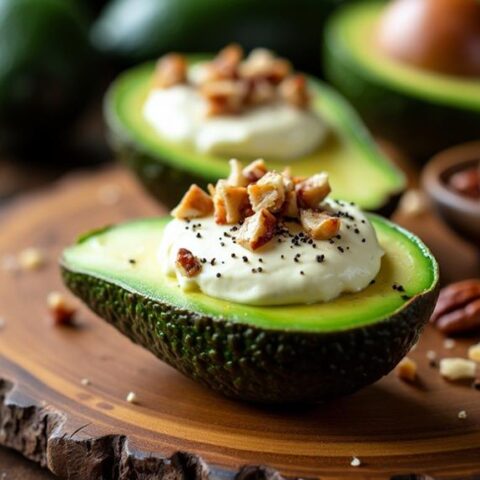

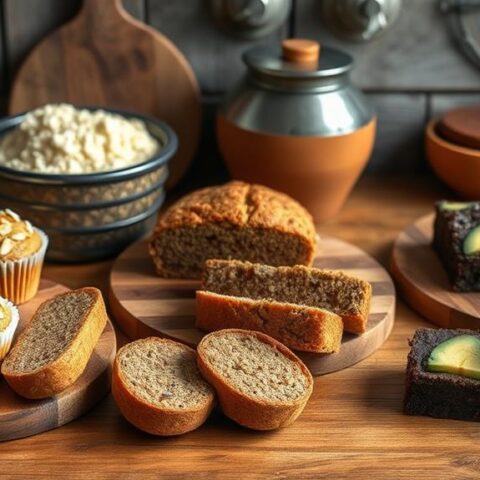
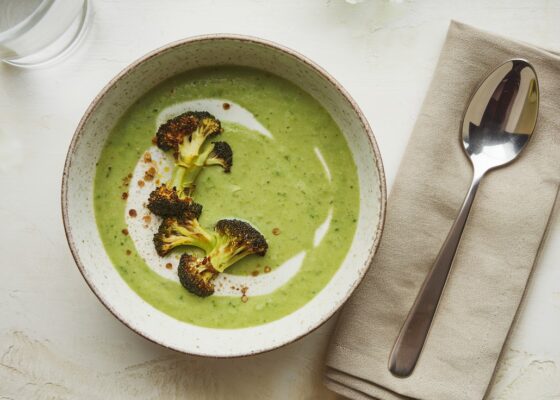

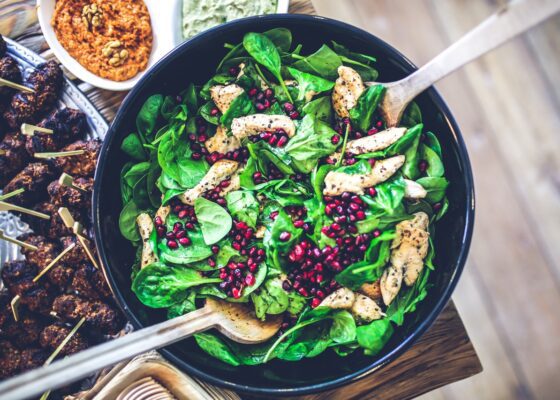

No Comments